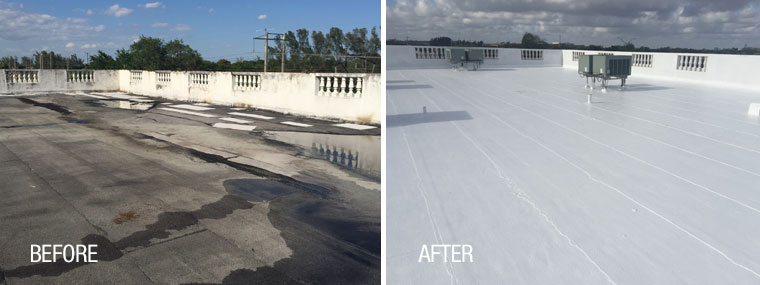
Stop the Deterioration
Utilize Roof Restoration
By Judi Lynn / Published Nov 2015

Roofs are an important element to take care of in a community association. As a board of directors, your desire and duty is to maintain your community while not placing a heavier than necessary financial burden on your fellow residents. This article aims to help you understand the practical and financial differences between a roof restoration versus a roof tear off and replacement.
Roof Deterioration is the Problem
Roof deterioration manifests itself in a variety of ways depending on the type of roof your community has.
- On Tile Roofs—worn tiles and cracked cement
- On Flat Mod Bit Roofs—ponding water; cracked tar around vent pipes, drain openings, and A/C stands along with granules worn off and seams separating.
- On Asphalt Roofs—rusted nails protruding, grit worn off the asphalt exposing the black tar.
One of the contributing factors to roof deterioration in Florida is the fact that the state is located in a higher frequency temperature region with elevated levels of humidity, airborne salt water droplets, and advanced ultraviolet rays from the sun in comparison to other states.
Because of these conditions, the deterioration of modified bitumen flat roofs, asphalt shingle roofs, including tile and metal roofs as well will cause corrosion and deterioration of all these types of roofs, eliminating their effectiveness and causing overall inadequate protection. Unfortunately, if left unchecked, these conditions will ultimately lead to the need for a total re-roofing.
Factually, homes and buildings have been re-roofed time and time again, which is not only extremely costly but unnecessary since most of the time there are only some small areas in need of minor repair with less than 25 percent of the substrate failing. The Florida Building Code (FBC), Section 611 Reroofing states that if 25 percent or less of the substrate is not up to code, re-roofing is avoidable. Typically, the problem with not re-roofing is that the repair work done by the roofing contractor is only taking care of those problem areas temporarily. Over time, if left unchecked, water will find its way in destroying additional areas on the roof and continue to travel to other areas of the roof, which causes further complications. In addition, the warranties on those repairs are usually only good for six months to a year.
Judi Lynn
President, Rhino Roof Protection Coating
Judi Lynn is with Rhino Roof Protection Coatings, a division of the parent company, White Glove Painting. Rhino Roof provides waterproofing, energy savings, mold and mildew resistance, eliminates pressure cleaning problems, and extends the life of A/C units. Restoration is their primary goal—rather than succumbing to the deterioration of the roof substrate or tearing off and building a new roof. For more information, call (561) 236-7305 or visit www.rhinoroofprotection.com.
Fortunately, the most effective fix is found in roof restoration, which is actually less than one-third the cost of a new roof. Roof restoration offers 10–20 year warranties and is far more cost effective in many ways with benefits that re-roofing cannot provide. To begin with, 100 percent breathable silicone creates a monolithic, solid seamless membrane on flat modified bitumen roofs, which is permanent ponding water resistant. There are no seams to lift. This coating produces excellent adhesion and flexibility, is VOC compliant, and solvent-free. Water will not penetrate it. This, in turn, reduces the temperature while saving energy as a result of reflecting heat on top of the roofs by as much as 75 degrees and inside the building by 6–10 degrees. On asphalt, metal, and tile roofs, an acrylic, breathable UV protective coating will produce benefits such as a long-lasting waterproof seal, superior UV resistance weathering characteristics, and are also mold and mildew resistant. Acrylic Teflon coatings come in a wide variety of color choices or a clear coat. They scientifically deliver a self-cleaning nanotechnology and come with a 12 year warranty.
We have had success using these solutions in several communities and for many building owners. One project experience came to fruition when we were contacted by Terry Siebert of Beach View Condominium and a board president of the community that had tile roofs. Regrettably, this tile was inundated with mold and mildew and peeling roof paint. The existing problem was that they had to pressure clean the tiles every 18 months or so, and the pressure cleaning companies were breaking tiles and pressure cleaning with 4,000 lbs. of pressure continuously wearing down the tiles. Characteristic of all tile roofs, they had cracked cement with cracks around vent pipes from split tar and caulking. All the tiles were replaced and the cracked cement, tar, and caulking were filled with an expandable pointing compound. When finished, their roofs looked better than new and their A/C units didn’t have to work as hard. When we followed up, they were extremely satisfied with the service received and the utilization of the cool roof product.
In conclusion, roof restoration is unique and innovative with concepts that enable consumers the choice of protection rather than succumbing to the deterioration of their roofs or having their roofs torn off with the costly expense of building a new one. With proper application, cool roof products can actually be better than a new roof. They last longer, offer superior protection, and save money from the moment they’re applied to any type of roof. These coatings are FPL rated, which can be used for rebates and insurance credits.


